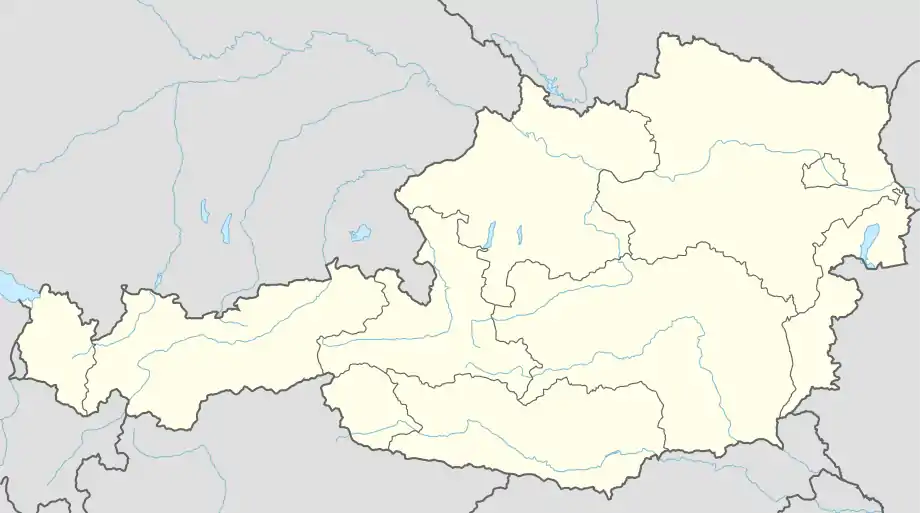Bruck an der Mur
Bruck an der Mur is a city of some 13,500 people located in the district Bruck-Mürzzuschlag, in the Austrian state of Styria. It is located at the confluence of the Mur and Mürz Rivers. Its manufacturing includes metal products and paper. Bruck is located on the Graz to Vienna main line, and is an important regional rail junction.
Bruck an der Mur | |
|---|---|
 Kornmesserhaus in Bruck an der Mur | |
 Coat of arms | |
 Bruck an der Mur Location within Austria | |
| Coordinates: 47°25′00″N 15°16′00″E | |
| Country | Austria |
| State | Styria |
| District | Bruck-Mürzzuschlag |
| Government | |
| • Mayor | Bernd Rosenberger (SPÖ) |
| Area | |
| • Total | 85.43 km2 (32.98 sq mi) |
| Elevation | 468 m (1,535 ft) |
| Population (2018-01-01)[2] | |
| • Total | 15,885 |
| • Density | 190/km2 (480/sq mi) |
| Time zone | UTC+1 (CET) |
| • Summer (DST) | UTC+2 (CEST) |
| Postal code | 8600 |
| Area code | 03862 |
| Vehicle registration | BM |
| Website | www.bruckmur.at |
History
The earliest surviving record of Bruck dates from the time of King Ludovicus II "Germanicus", when it was identified, in a record dated 20 November 860, as "ad pruccam", a manor of the archbishopric of Salzburg. The settlement then identified with this name was in the location currently occupied by the suburb now called "St. Ruprecht". The settlement then located at what is now the centre of Bruck is identified in the ninth century record as "muorica kimundi" (i.e. the mouth of the Mürz River).
The town was refounded in 1263 by King Otakar II of Bohemia, who was responsible for surrounding Bruck with its city walls. Bruck received its town privileges in 1277 from King Rudolph von Habsburg who in 1273 succeeded Otakar. Bruck an der Mur was an important medieval trade center specializing in iron work.
Main sights
There is a 15th-century Gothic church in the city.
In the centre, there is also the famous Kornmesser house, built in the Venetian style by Pankraz Kornmess in the 15th century. There is also the Iron Well with its famous lace-like dome.
The castle of Landskron burned down in the great fire of 1792. After that fire, just two of 166 houses were left standing.
Culture
Near Bruck is a recreation area called Weitental. Every August a well-known artist and clown festival called Murenschalk is held.
Sister cities
Bruck an der Mur is twinned with:
 Hagen-Hohenlimburg, Germany
Hagen-Hohenlimburg, Germany Liévin, France
Liévin, France Veroli, Italy
Veroli, Italy
People
- Ernest, Duke of Austria (1377 in Bruck an der Mur – 1424) member of the House of Habsburg, ruled over the Inner Austrian duchies of Styria, Carinthia and Carniola from 1406 until his death
- Rudolf Stöger-Steiner von Steinstätten (1861 in Pernegg an der Mur – 1921) Colonel-General in the Austro-Hungarian army
- Richard Kretz (1865 in Bruck an der Mur – 1920) pathologist, particularly liver cirrhosis
- Menci Clement Crnčić (1865 in Bruck an der Mur – 1930 in Zagreb) Croatian painter, printmaker, teacher and museum director
- Edmund Hlawka (1916 in Bruck an der Mur – 2009) mathematician and number theorist
- Hanns Malissa (1920 in Bruck an der Mur – 2010) analytical chemist and environmental chemist
- Christian Anders (born 1945 in Bruck an der Mur) singer, musician, composer and author.
- Eva Rueber-Staier (born 1951 in Bruck an der Mur) actress, TV Host, model, beauty queen, won Miss World 1969
- Erwin Wurm (born 1954 in Bruck an der Mur) artist, currently lives and works in Vienna and Limberg
- Werner S. Weiglhofer (born on August 25, 1962 in Bruck an den Mur, died on January 12, 2003 in Andalsnes, Norway), theoretical electromagnetcist and Professor of Mathematics at the University of Glasgow [3]
- Ille Gebeshuber (born 1969 in Bruck an der Mur) physicist, specializes in nanophysics and biomimetics
- Elisabeth Görgl (born 1981 in Bruck an der Mur) retired World Cup alpine ski racer
- Florian Neukart (born 1982 in Bruck an der Mur) computer scientist and mathematician, specializes in quantum computing and artificial intelligence
References
- "Dauersiedlungsraum der Gemeinden Politischen Bezirke und Bundesländer - Gebietsstand 1.1.2018". Statistics Austria. Retrieved 10 March 2019.
- "Einwohnerzahl 1.1.2018 nach Gemeinden mit Status, Gebietsstand 1.1.2018". Statistics Austria. Retrieved 9 March 2019.
- "Werner S. Weiglhofer's research while affiliated with University of Glasgow and other places".